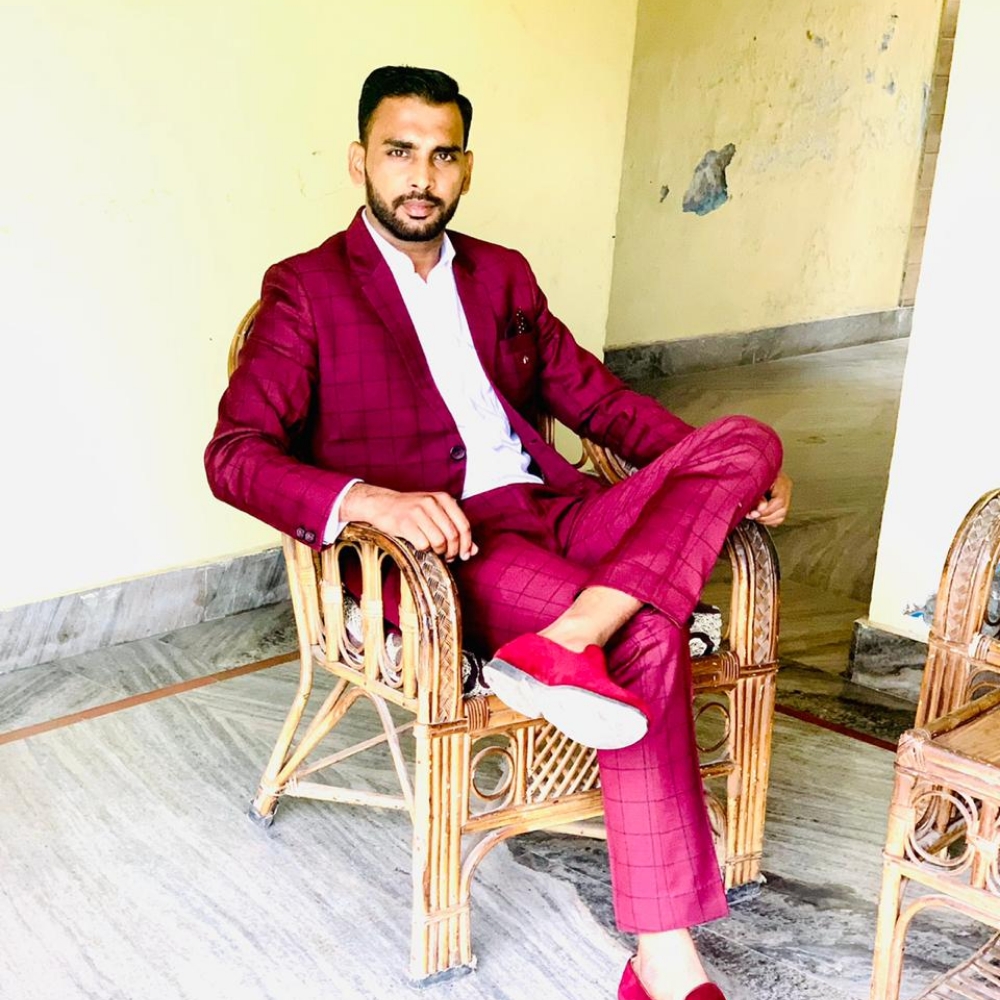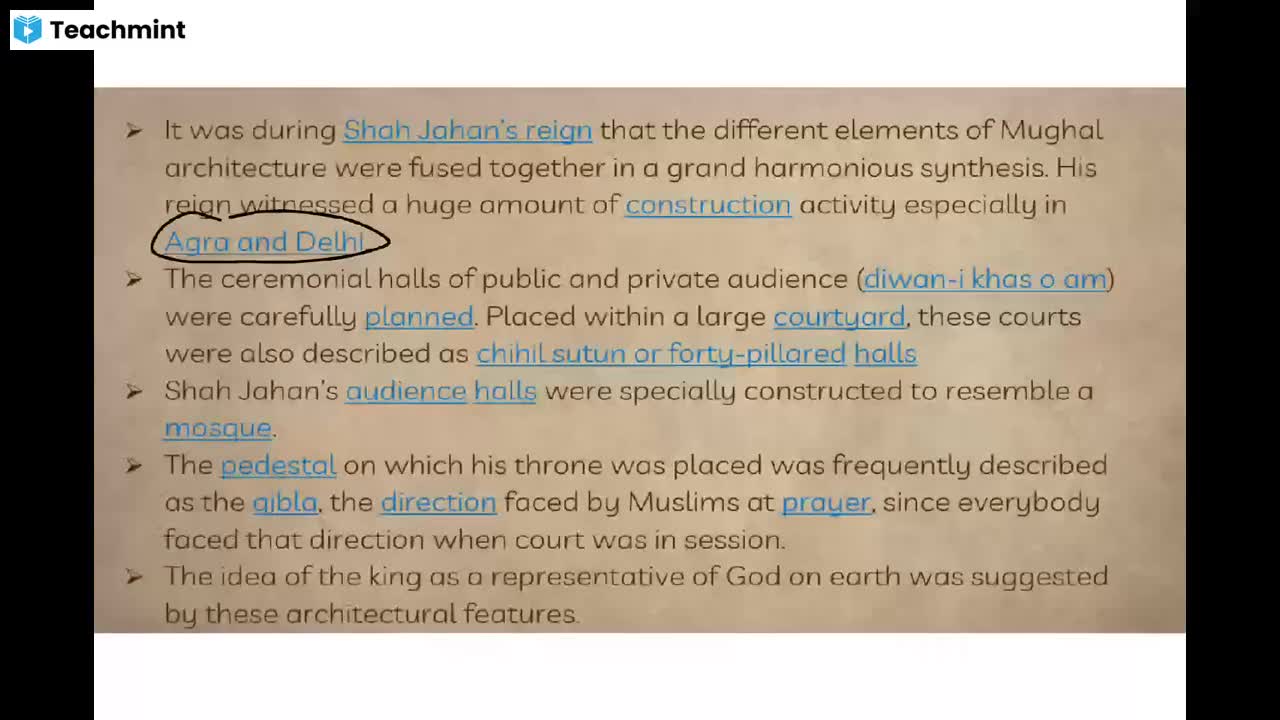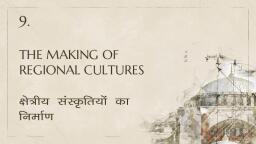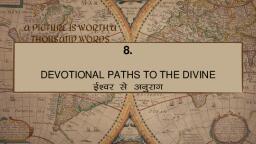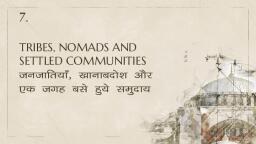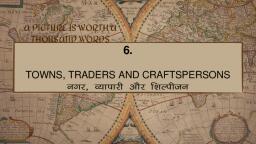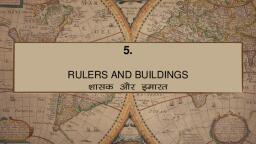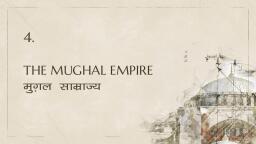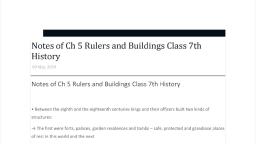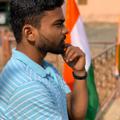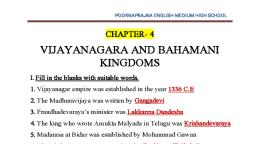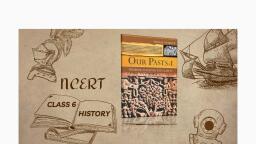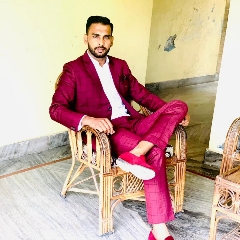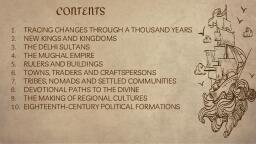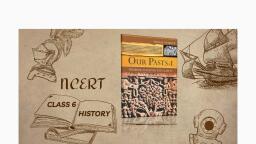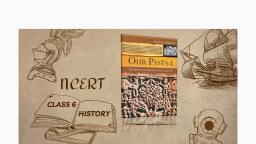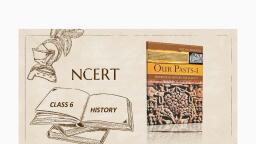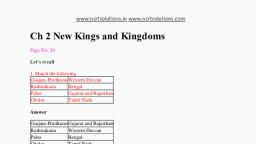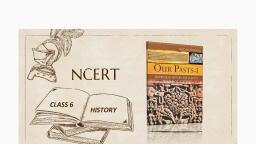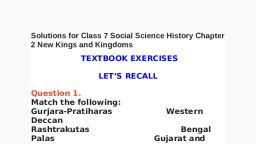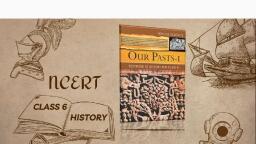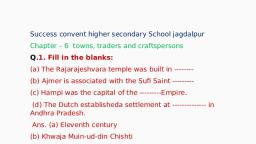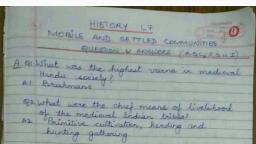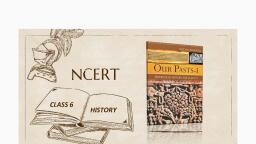Page 2 :
OVERVIEW, 1., 2., 3., 4., 5., 6., 7., 8., 9., 10., 4, , THE EMERGENCE OF NEW DYNASTIES, ADMINISTRATION IN THE KINGDOMS, PRASHASTIS AND LAND GRANTS, WHAT WAS GIVEN WITH THE LAND, WARFARE FOR WEALTH, FROM URAIYUR TO THANJAVUR, SPLENDID TEMPLES AND BRONZE SCULPTURE, AGRICULTURE AND IRRIGATION, THE ADMINISTRATION OF THE EMPIRE, WHO COULD BE A MEMBER OF A SABHA ?
Page 4 :
The Emergence of New Dynasties, (u, jktoa'kksa dk mn;), ⬗ There were big landlords or warrior chiefs in different regions of, the subcontinent. Existing kings often acknowledged them as their, subordinates or samantas, ⬗ They were expected to bring gifts for their kings or overlords, be, present at their courts and provide them with military support., ⬗ As samantas gained power and wealth, they declared themselves to, be maha-samanta, maha-mandaleshvara (the great lord of a, “circle” or region) and so on. Sometimes they asserted their, independence from their overlords., 6
Page 5 :
⬗ One such instance was that of the Rashtrakutas in the Deccan., Initially they were subordinate to the Chalukyas of Karnataka., ⬗ In the mid-eighth century, Dantidurga, a Rashtrakuta chief,, overthrew his Chalukya overlord and performed a ritual called, hiranya-garbha (literally, the golden womb)., ⬗ When this ritual was performed with the help of Brahmanas, it was, thought to lead to the “rebirth” of the sacrificer as a Kshatriya,, even if he was not one by birth., , 7
Page 6 :
8
Page 7 :
⬗ In other cases, men from enterprising families used their military, skills to carve out kingdoms., ⬗ For instance, the Kadamba Mayurasharman and the Gurjara, Pratihara Harichandra were Brahmanas who gave up their traditional, professions and took to arms, successfully establishing kingdoms in, Karnataka and Rajasthan respectively., , 9
Page 9 :
11
Page 11 :
⬗ In each of these states, resources were obtained from the producers – that, is, peasants, cattle-keepers, artisans – who were often persuaded or, compelled to surrender part of what they produced. Sometimes these, were claimed as “rent” due to a lord who asserted that he owned the land., Revenue was also collected from traders., , ⬗ These resources were used to finance the king’s establishment, as well as, for the construction of temples and forts., , ⬗ They were also used to fight wars, which were in turn expected to lead to, , the acquisition of wealth in the form of plunder, and access to land as well, as trade routes., , 13
Page 12 :
⬗ The functionaries for collecting revenue were generally, recruited from influential families, and positions were often, hereditary., ⬗ This was true about the army as well. In many cases, close, relatives of the king held these positions., , 14
Page 13 :
FOUR HUNDRED TAXES! ( pkj lkS dj!), ⬗ The inscriptions (vfHkys[k)of the Cholas who ruled in Tamil Nadu, ,referred to more than 400 terms for different kinds of taxes., , ⬗ The most frequently mentioned tax is vetti, taken not in cash but in the, form of forced labour, and kadamai, or land revenue., , ⬗ There were also taxes on thatching the house, the use of a ladder to, climb palm trees, a cess on succession to family property, etc., , 15
Page 14 :
16
Page 15 :
Prashastis and Land Grants, (iz'kfLr;k¡ vkSj Hkwfe&vuqnku), ➢These were composed by learned Brahmanas, who occasionally helped in, , the administration., ➢Kings often rewarded Brahmanas by grants of land. These were recorded on, copper plates, which were given to those who received the land., ➢Unusual for the twelfth century was a long Sanskrit poem containing the, , history of kings who ruled over Kashmir. It was composed by an author, named Kalhana. He used a variety of sources, including inscriptions,, documents, eyewitness accounts and earlier histories, to write his account., Unlike the writers of prashastis, he was often critical about rulers and their, policies., 17
Page 17 :
19
Page 18 :
What was given with the land, , 20, , ➢This is part of the Tamil section of a land grant given by the Cholas:, ➢We have demarcated the boundaries of the land by making earthen embankments,, as well as by planting thorny bushes. This is what the land contains: fruit-bearing, trees, water, land, gardens and orchards, trees, wells, open spaces, pastureland, a, village, anthills, platforms, canals, ditches, rivers, silt-laden land, tanks, granaries, fish, ponds, bee hives, and deep lakes., ➢He who receives the land can collect taxes from it. He can collect the taxes, imposed by judicial officers as fines, the tax on betel-leaves, that on woven cloth, as, well as on vehicles. He can build large rooms, with upper stories made of baked, bricks, he can get large and small wells dug, he can plant trees and thorny bushes, if, necessary, he can get canals constructed for irrigation. He should ensure that water is, not wasted, and that embankments are built
Page 19 :
⬗ This is a set of copper plates, , recording a grant of land made by, a ruler in the ninth century,, written partly in Sanskrit and, partly in Tamil. The ring holding, the plates together is secured with, the royal seal, to indicate that this, is an authentic document., , 21
Page 20 :
Warfare for Wealth, ➢For centuries, rulers belonging to the Gurjara-Pratihara, Rashtrakuta and, Pala dynasties fought for control over Kanauj. Because there were three, “parties” in this longdrawn conflict, historians often describe it as the, “tripartite struggle”., , ➢Rulers also tried to demonstrate their power and resources by building, , large temples. So, when they attacked one another’s kingdoms, they often, chose to target temples, which were sometimes extremely rich., , 22
Page 21 :
23
Page 22 :
Warfare for Wealth, ➢One of the best known of such rulers is Sultan Mahmud of Ghazni,, , Afghanistan. He ruled from 997 to 1030, and extended control over parts of, Central Asia, Iran and the north-western part of the subcontinent. He raided, the subcontinent almost every year – his targets were wealthy temples,, including that of Somnath, Gujarat. Much of the wealth Mahmud carried, away was used to create a splendid capital city at Ghazni, , ➢Sultan Mahmud was also interested in finding out more about the people, , he conquered, and entrusted a scholar named Al-Biruni to write an account, of the subcontinent. This Arabic work, known as the Kitab ul-Hind, remains, an important source for historians. He consulted Sanskrit scholars to prepare, this account, 24
Page 23 :
25
Page 24 :
➢Sultan :- An Arabic term meaning ruler., ➢Other kings who engaged in warfare included the Chahamanas, later known as the, Chauhans, who ruled over the region around Delhi and Ajmer., , ➢, ➢They attempted to expand their control to the west and the east, where they were, , opposed by the Chalukyas of Gujarat and the Gahadavalas of western Uttar Pradesh., , ➢ The best-known Chahamana ruler was Prithviraja III (1168-1192), who defeated an, Afghan ruler named Sultan Muhammad Ghori in 1191, but lost to him the very next, year, in 1192., 26
Page 25 :
27
Page 27 :
From Uraiyur to Thanjavur, A minor chiefly family known as the Muttaraiyar held power in the Kaveri delta. They, were subordinate to the Pallava kings of Kanchipuram. Vijayalaya, who belonged to the, ancient chiefly family of the Cholas from Uraiyur, captured the delta from the, Muttaraiyar in the middle of the ninth century. He built the town of Thanjavur and a, temple for goddess Nishumbhasudini there., The successors of Vijayalaya conquered neighbouring regions and the kingdom grew in, size and power. The Pandyan and the Pallava territories to the south and north were, made part of this kingdom., , 29
Page 28 :
Rajaraja I, considered the most powerful Chola ruler, became, king in 985 and expanded control over most of these areas. He, also reorganised the administration of the empire., Rajaraja’s son Rajendra I continued his policies and even raided, the Ganga valley, Sri Lanka and countries of Southeast Asia,, developing a navy for these expeditions, , 30
Page 29 :
Splendid Temples and Bronze Sculpture, The big temples of Thanjavur and Gangaikondacholapuram, built by Rajaraja and, Rajendra, are architectural and sculptural marvels., Chola temples often became the nuclei of settlements which grew around them., These were centres of craft production., Temples were also endowed with land by rulers as went into maintaining all the, specialists who worked at the temple and very often lived near it – priests, garland, makers, cooks, sweepers, musicians, dancers, etc., 31
Page 30 :
32
Page 31 :
Splendid Temples and Bronze Sculpture, (HkO; eafnj vkSj dkaL; ewfrZdyk), Temples were not only places of worship; they were the hub of economic,, social and cultural life ., Amongst the crafts associated with temples, the making of bronze images was, the most distinctive. Chola bronze images are considered amongst the finest, in the world. While most images were of deities, sometimes images were made, of devotees as well., , 33
Page 32 :
The temple at, Gangaikondacholapuram., Notice the way in which the, roof tapers. Also look at the, elaborate stone sculptures used, to decorate the outer walls., , 34
Page 34 :
Agriculture and Irrigation, The river Kaveri , branches off into several small channels before emptying into the Bay, of Bengal. These channels overflow frequently, depositing fertile soil on their banks., Water from the channels also provides the necessary moisture for agriculture, particularly, the cultivation of rice., Although agriculture had developed earlier in other parts of Tamil Nadu, it was only from, the fifth or sixth century that this area was opened up for large-scale cultivation. Forests, had to be cleared in some regions; land had to be levelled in other areas. In the delta region, embankments had to be built to prevent flooding and canals had to be constructed, tocarry water to the fields. In many areas two crops were grown in a year., , 36
Page 35 :
Agriculture and Irrigation, In many cases it was necessary to water crops artificially. A variety of methods were, used for irrigation., In some areas wells were dug. In other places huge tanks were constructed to, collect rainwater., , Remember that irrigation works require planning – organising labour and, resources, maintaining these works and deciding on how water is to be shared., Most of the new rulers, as well as people living in villages, took an active interest in, these activities., 37
Page 36 :
A ninth-century sluicegate in Tamil Nadu., It regulated the outflow of water from a tank, into the channels that irrigated the fields., A sluice gate is traditionally a wood or metal, barrier which is commonly used to control, water levels and flow rates in rivers and canals., , 38
Page 37 :
The Administration of the Empire, Settlements of peasants, known as ur, became prosperous with, the spread of irrigation agriculture., Groups of such villages formed larger units called nadu., The village council and the nadu performed several, administrative functions including dispensing justice and, collecting taxes., 39
Page 38 :
The Administration of the Empire, Rich peasants of the Vellala caste exercised considerable control over, the affairs of the nadu under the supervision of the central Chola, government., , The Chola kings gave some rich landowners titles like muvendavelan (a, velan or peasant serving three kings), araiyar (chief), etc. as markers of, respect, and entrusted them with important offices of the state at the, centre., 40
Page 39 :
The Administration of the Empire, Brahmanas often received land grants or brahmadeya., As a result, a large number of Brahmana settlements emerged in the Kaveri valley as in, other parts of south India., Each brahmadeya was looked after by an assembly or sabha of prominent Brahmana, landholders. These assemblies worked very efficiently., Their decisions were recorded in detail in inscriptions, often on the stone walls of, temples., Associations of traders known as nagarams also occasionally performed administrative, functions in towns, 41
Page 40 :
The Administration of the Empire, Inscriptions from Uttaramerur in Chingleput district, Tamil Nadu, provide, details of the way in which the sabha was organised., The sabha had separate committees to look after irrigation works, gardens,, temples, etc. Names of those eligible to be members of these committees were, written on small tickets of palm leaf; these tickets were put into an earthenware, pot, from which a young boy was asked to take out the tickets, one by one for, each committee., , 42
Page 43 :
WHO COULD BE A MEMBER OF A SABHA ?, The Uttaramerur inscription lays down:, All those who wish to become members of the sabha should be owners of land from, which land revenue is collected. They should have their own homes., They should be between 35 and 70 years of age., They should have knowledge of the Vedas. They should be well-versed in, administrative matters and honest., If anyone has been a member of any committee in the last three years, he cannot, become a member of another committee. Anyone who has not submitted his accounts,, and those of his relatives, cannot contest the elections., 45
Page 44 :
While inscriptions tell us about kings and powerful men, here is an excerpt from, the Periyapuranam, a twelfthcentury Tamil work, which informs us about the, lives of ordinary men and women., , On the outskirts of Adanur was a small hamlet of Pulaiyas (a name used for a, social group considered “outcastes” by Brahmanas and Vellalas), studded with, small huts under old thatches and inhabited by agrarian labourers engaged in, menial occupations. In the thresholds of the huts covered with strips of leather,, little chickens moved about in groups; dark children who wore bracelets of, black iron were prancing about, carrying little puppies …, , 46
Page 45 :
…In the shade of the marudu (arjuna) trees, a female labourer put her, baby to sleep on a sheet of leather; there were mango trees from whose, branches drums were hanging; and under the coconut palms, in little, hollows on the ground, tiny-headed bitches lay after whelping. The redcrested cocks crowed before dawn calling the brawny Pulaiyar (plural) to, their day’s work; and by day, under the shade of the kanji tree spread the, voice of the wavy-haired Pulaiya women singing as they were husking, paddy …, , 47
Page 46 :
China under the Tang dynasty, In China, an empire was established under the Tang dynasty, which remained, in power for about 300 years (from the seventh to the tenth centuries)., Its capital, Xi’an, was one of the largest cities in the world, visited by Turks,, Iranians, Indians, Japanese and Koreans., The Tang empire was administered by a bureaucracy recruited through an, examination, which was open to all who wished to appear for it. This system, of selecting officials remained in place, with some changes, till 1911., , 48
Page 47 :
China under the Tang dynasty, , 49
Page 48 :
China under the Tang dynasty, , 50
Page 50 :
Thanks!, , 52
